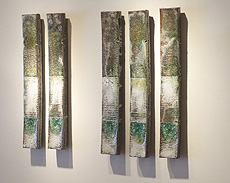Working with the elements: "Creativity is not Created" comes to Fermilab Art Gallery
 |
| Chicago artist Jay Strommen works in glass and clay. His work is currently on display in the Fermilab Art Gallery. |
For years, Chicago artist Jay Strommen has molded, baked and grinded clay to combine the four elements — earth, air, water and fire — in new ways. The resulting ceramic objects are part of an evolution not only in his own artistic development, he says, but with roots in techniques used centuries ago.
The latest exhibit at the Fermilab Art Gallery, "Creativity is not Created," features moments in that evolution that easily could be passed over but that invite close inspection, Strommen says. An artist reception will be held on Friday at 5 p.m. in the gallery.
The exhibit showcases studies on paper for sculptural pieces and works in clay and glass that Strommen developed when he was exploring various kiln techniques.
Strommen's method for firing clay has its foundation in 16th-century Japanese kiln technology. While the people of that culture created their ceramics for utility — gathering, storage, eating — today their vessels have aesthetic value.
"They were useful objects," Strommen said. "Now they're art." That simple statement, he says, reminds us that creativity does not arise out of thin air, but is the result of labor and practice. Uncovering the creativity that goes into the workmanship lies with the viewer.
"I'm framing bits and pieces of tradition that otherwise would have been overlooked," Strommen said.
One exhibit piece features a pallet piled with thousands of clay tokens, each made by hand, each different. The small, palm-sized formations could be dismissed easily as so many one-offs, but the viewer is instead invited to appreciate both the craft and the industry that went into making each one. He or she can even take one home.
In the same spirit of drawing the viewer closely to the art, Strommen has inscribed messages on the reverse sides of some of his gleaming glass-and-clay tablets. Ultimately, that close inspection could bring the viewer back to the elements that lie at the foundation of the interaction.
"I'm collaborating with nature and tradition," he said. "I'm a catalyst that's bringing the elements together in a framed environment."
|